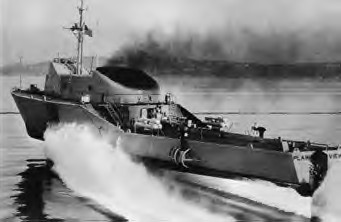In December 1960, the US Navy Bureau of Ships issued a requirements document for a hydrofoil research ship designated the AGEH-1. This designation stands for Ocean-Going Auxiliary (A), General (G), Experimental (E), Hydrofoil (H). It was to be a 50-knot hydrofoil with provision for future conversion to achieve speeds up to 90 knots! This was to be accomplished by addition of two more gas turbines and a supercavitating strut foil system. Its purpose was to provide criteria for design of future Navy hydrofoil ships and to explore the utility of such ships for Anti-Submarine Warfare (ASW) and other Navy missions.
Proposals for Plainview were submitted by a number of contractors. Grumman Aircraft Engineering Corporation (now named Grumman Aerospace Corporation) was selected as the contractor based on their submission, which consisted of two different concepts. One had fixed foils that could be retracted only with a crane at dockside. The other had a fully self-contained foil retraction system. The fully-retractable design was selected and, on 26 October 1961, Grumman was awarded a cost-type contract for the guidance design of AGEH-1. The Grumman team included Newport News Shipbuilding Corp. and General Electric Co. Grumman was designated the Program Manager and principal designer, and it was proposed that they build the foils and install the transmission. Newport News was to be involved in the design of the shipboard systems and the hull, and would be the hull builder and outfitter. The General Electric Co. had the responsibility for the propulsion system.
The guidance design took about one year, followed by preliminary design and weight estimates submittal and approval in February 1962. The contract drawings and final draft of the specifications were signed off by the Navy on 9 October 1962. Grumman's estimate for detail design and construction was about $17M. Since the Navy had budgeted only $12M, they exercised their option to recompete the procurement. Additional bids were received, all of which were in the neighborhood of $17M, except for the bid of Puget Sound Bridge and Drydock Co. in Seattle, Washington (later to become Lockheed Shipbuilding and Construction Co.). They bid just under $12M and, on 9 July 1963, were awarded a fixed-price contract for detail design and construction. The contract for this 320-ton advanced hydrofoil, the largest ever constructed, was only seven pages long. As it turned out, the actual cost of the ship, including changes, was close to $21M.
There were numerous contributors to the design and construction of PLAINVIEW under the overall responsibility of Lockheed Shipbuilding and Construction Co. These were W. C. Nickum & Sons for engineering and detail design, Rucker for the design of the hydraulic system, General Electric for the design and construction of the hullborne and foilborne transmissions, Hamilton Standard for the automatic control system, and Lockheed California for design and construction of the strut/foil system.
The keel was laid on 8 May 1964, and the ship was launched on 28 June 1965. It was christened PLAINVIEW in honor of Plainview, New York and Texas. The ship made its first foilborne flight of 11-1/2 minutes on 21 March 1968, but it was nearly a year later, on 3 February 1969, that it began Preliminary Acceptance Trials. On 1 March 1969, the Navy reluctantly took delivery and assigned the ship to the Navy Hydrofoil Special Trials Unit (HYSTU) located at the Puget Sound Naval Shipyard in Bremerton, Washington for administrative and technical control. This was nearly 3-1/2 years later than the originally projected delivery date. Much of this delay was due to 3 major strikes during the construction period. PLAINVIEW was far from problem free at time of delivery. The Navy decided that its best course of action was to undertake its own program of deficiency correction if the ship was every to become fully operational. Final Contract Trials were begun on 21 January 1970, and on 2 March 1970, the Navy accepted the ship.
This 320-ton hydrofoil was characterized by its long, slender. One might wonder why there was no "A" on the hull of PLAINVIEW in view of its "AGEH-1" designation. It turns out that it is not customary to include the "A" on the hull of US Navy auxiliary ships.
The ship had a length of 212 feet and an extreme beam with foils down of 70.8 feet. It attained foilborne speeds of over 50 knots from two General Electric LM-1500 gas turbine engines driving two supercavitating propellers. Two Packard diesel engines drove propellers for low-speed hullborne operations.
The large foils were forward, and a smaller foil was located aft, which puts the PLAINVIEW foil arrangement in the conventional, or airplane category.
Unfortunately, soon after emerging from a program of deficiencies correction and returning to the trials program with many successful operations in its log, PLAINVIEW fell victim to the Congressional budget knife. She made her last foilborne flight on 17 July 1978, ending with a total of 268 foilborne hours and without ever being tested to the limits of her rough water capability. The ship was officially inactivated on 22 September 1978 and towed to the inactive fleet at Bremerton WA. In May of 1979, the hull (less the struts and foils, gas turbines, and other special equipment) was sold to a private party for the sum of $128,000. The engines, foils, and transmissions were retained by the Navy for possible use on another prototype hydrofoil or another advanced naval vehicle. It was understood that the ship was to be converted for use as a fishing boat. This was either unsuccessful or was never attempted. The final indignity for this once proud and beautiful ship was being relegated to resting on a mud flat near Astoria Oregon.
 Manufacturer: Grumman, General Electric, Newport News, Lockheed Martin
Manufacturer: Grumman, General Electric, Newport News, Lockheed Martin
Propulsion hullborne: Two Packard diesel engines
Propulsion foilborne: Two General Electric LM-1500 gas turbine engines with two super-cavitating propellers
Length: 212 feet
Beam: 70.8 feet
Displacement: 320 tons
Design Speed, foilborne: 50 knots
